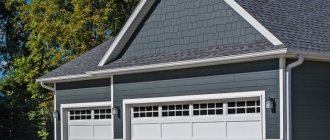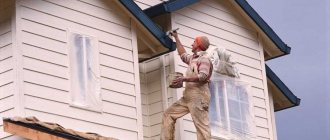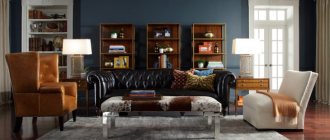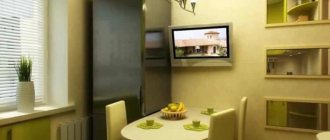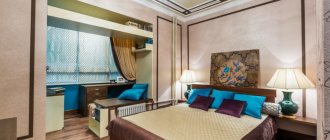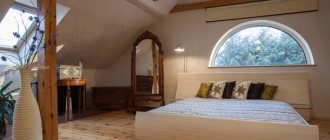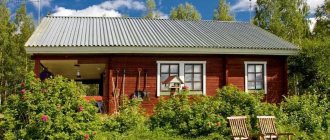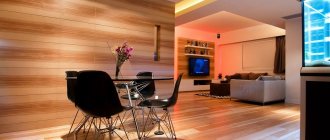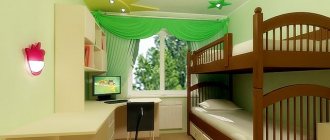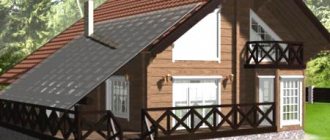Of primary importance when building a wooden house is the quality of the wood used. The choice of wood for building a house should be approached very carefully. Properly selected and applied in accordance with the manufacturer’s recommendations, facade paints, antiseptics, and wood glazes will effectively protect a wooden house from precipitation and UV, and keep it in excellent condition for many years.
Now it’s the 21st century and wood as a construction material is experiencing another surge in popularity. The craving for naturalness and natural materials is understandable. But it is not enough to build a wooden house or cottage, you need to provide them with proper care, and in order for the wood to last a long time and not lose its attractiveness, the house needs to be painted. When builders guarantee that a wooden building will last a hundred years, they mean its timely and correct protection from destruction.
Harmoniously selected color when painting a house
Why you need to protect a tree
Professional builders recommend painting a wooden house right away so that it lasts longer. Unprotected wood is negatively affected by almost all environmental factors. If a living tree is covered with bark, then only painting will protect the logs or boards.
- Exposed wood is destroyed by exposure to the sun's rays. Ultraviolet radiation affects lignin, a substance responsible for the lignification of plant cells. As a result, the wood darkens, becomes loose and damp. A fundamental change in the material occurs after six months of being in the open air. Since painting a wooden house over a damaged surface layer will not bring the desired result, you must first sand the surface to an undamaged material.
The logs of the log house dry out and crack over time.
Under the influence of ultraviolet radiation and temperature changes, the boards darkened and cracked
The cracked end of a log
- The alternation of rain and dry weather causes the wood to periodically swell and dry out unevenly. The result of the process is cracks of varying depths, which gradually increase. The house becomes unsightly and its ability to retain heat decreases. In addition, mold fungi settle in the cracks and rotting begins.
- Temperature changes in winter lead to moisture entering the pores of the wood during the thaw and then freezing. Ice crystals can tear wood fibers, forming cracks in the depths. Repeated repetition threatens that cracks will spread not only on the surface, but throughout the entire thickness of the frame.
Exterior painting of a wooden house creates a protective layer that serves as a barrier to negative influences.
Types of paints
The abundance of modern paints and varnishes provides various options for solving the problem of how to paint the outside of a wooden house. All types of exterior or facade paint are divided into:
- glaze, i.e. translucent, preserving the appearance and texture of wood, having antiseptic properties;
- covering paints are oil, acrylic and alkyd paints that form an additional layer on top of the wood.
Types of paints and their differences in composition
Materials differ in composition, drying speed, appearance and other characteristics. Experts have not come to a clear conclusion about which paint is best to paint the outside of wooden houses, so you need to choose taking into account the wood from which the house is built (dry, damp, treated, old, etc.) and the climatic features of the area.
When choosing high-quality products, the preservation of wood is ensured for up to 15 years. Such a long-lasting and reliable effect can only be achieved by following the rules of painting and preliminary preparation.
House paint
Types of material
In the first step, we need to determine what exterior house paint will look best.
And here the choice depends on a number of parameters, the main one of which will be the wall material.
- For wooden structures, special compositions based on varnishes and impregnations are optimal. As a rule, they penetrate quite deeply into the wood structure, which ensures very effective surface protection.
Protective composition for wood
- Plastered walls should be painted with other compounds. For these paints, the most important properties will be moisture resistance and vapor permeability.
As for the varieties on sale, we will make a choice from the following options:
- Oil paints on various drying oils. They are quite cheap and easy to use; in addition, if the processing rules are followed, they provide acceptable vapor permeability. Although oil pigments are considered economical options, painting the outside of a timber house using them would be a completely rational solution.
- Alkyd and polyurethane enamels. They provide the maximum degree of protection; after polymerization, they form a film of thin plastic with a glossy effect on the surface. Most often used to decorate individual elements.
Note! When applied, these paints emit toxic substances, so you need to wear personal protective equipment when working.
- Acrylic and latex water-dispersed complexes. Perhaps one of the best options for finishing both wooden and plastered structures. After application, they dry quickly enough to form a stable coating that does not discolor for a long time even in the bright sun. High-quality acrylic paints have one drawback - a very significant price.
Water-dispersible material
- Fire retardant paints for metal – Polistil, Phoenix, Proterm, etc. They are used to protect metal load-bearing structures from deformation in case of fire. Most often available in white.
- Protective compounds for steel products (Zinga electrically conductive paint and analogues from other manufacturers) can also be used in exterior finishing. Naturally, they need to be applied where there is a threat of corrosion.
Color spectrum
At the next stage, we need to think through and approve the design for painting the outside of the house.
And although this issue should be decided based on your artistic taste, we will still give some advice:
The photo shows a traditional color combination: a darker base and a light top part
- Firstly, the lighter the color scheme, the more often your home will require maintenance. On the other hand, walls painted with light paint will heat up much less in summer.
- Secondly, the combination of colors for painting the outside of a house should be in harmony with the shades of other elements: roofing, fencing, blind areas and natural stone cladding, etc. As a rule, we purchase all these parts already painted, and therefore it is worth agreeing on decorating plans in advance.
Light shades are more preferable
- Finally, don't forget about neighboring houses. If the facades on the plots are approximately on the same line, it is desirable that their colors are at least somehow in harmony with each other. Of course, you shouldn’t “chuck in” and buy one batch of paint for the entire street, but you can maintain the general color direction.
- It should also be noted that painting the exterior of a house will give a more attractive result if several colors are used. Thus, the base, window and door frames, etc. usually require contrasting highlighting.
Wood pre-treatment
In order for the paint to apply smoothly, absorb well and last a long time, you need to prepare the surface for painting. Before treating the outside of a wooden house with any compound, antiseptic or fireproof, it is necessary to level the surface and seal the cracks.
After finishing the construction of the house, it is necessary to seal the joints and putty the cracks
The main condition is that the wood must be dry with a moisture level of no more than 20%, so preparation begins in the dry and warm season. If you put paint on a wet surface, the internal moisture will evaporate and destroy the coating and tear it away from the base.
The dry surface is cleaned of dust and dirt. If stains and stains of resin are difficult to remove, you can use a solvent. It is advisable to sand wood that was previously exposed to the open air mechanically.
After sanding, painting is carried out within 48 hours to ensure that the maximum effect of sanding is preserved.
First, the surface is treated with antiseptic primers or wood impregnations. Sometimes builders take on this work, but they often use the cheapest compounds - not very effective for preserving wood and environmentally unsafe. It is recommended to use water-based antiseptics that protect against the formation of mold, mildew and other biological formations on wood.
Antiseptics for wood
The application of antiseptics is carried out in strict accordance with the instructions indicated on the packaging. You cannot process at subzero temperatures, even if manufacturers offer winter antiseptics.
Adviсe
- If you are really bad at combining colors, then make combinations with the simplest colors - white, gray and black, or use a ready-made solution;
- Also, a simple way to create a good color scheme is to use natural combinations, however, even here you need to be extremely careful, because some colors are completely unsuitable for building a house, for example, red and green;
- When choosing the color of the roof and facade, do not forget to maintain the style of the building under construction, for example, if the building is built in minimalism, then use simple colors, for example, gray and black;
- Do not neglect the use of special computer programs, as well as tables with color combinations.
Conclusion
Now you are familiar with specific solutions and know what logic to follow when choosing the colors of the facade and roof of a building, we hope that after reading you will not have questions like: “What color goes with a brown roof?”
The better to paint
Paint for the facade of a wooden house can be translucent, glossy or matte. Since the natural look of wood is most attractive, glazing facade materials, which are available in the form of antiseptics, glazes or oils, are very popular.
The peculiarity of these materials is that they do not hide the structure of the wood. The materials work as impregnations, penetrate deep and create a barrier to getting wet or exposed to ultraviolet rays (UV). Despite their transparency, glaze paints are available in a wide range of colors. The most famous manufacturers:
- Renocoll (Rhenocoll) Germany.
- Teknos Finland.
If there is a desire to hide the surface of the wood, then use façade covering paints, which are divided into:
- oil - made from oils of natural origin and organic solvents;
- alkyd - produced in organic solvents or aqueous solutions of alkyds;
- acrylate (acrylic) coatings - based on acrylic and copolymers (latex, vinyl, silicone).
These paints form an opaque protective film that completely hides the wood grain. Over time, they oxidize, cease to be elastic and crack. Subsequently, the top layer turns into a powdery white substance (paint chalking process). After a few years, the layer will need to be removed completely or partially and the work done again.
Acrylic paints are more expensive and have a high degree of elasticity.
Well-known manufacturers of covering paints:
- Tikkurila (Finland).
- Alpina (Germany).
- Dufa (Germany).
- Beckers (Sweden).
- Dulux (Netherlands).
- Marshall (Türkiye).
Facade acrylic paint Dulux
Tikkurila paints are well known among us
Impregnation for the protection of wooden surfaces from Dufa
Among the Russian brands, the most popular are “Optimist”, “Svyatozar”, “Tex”, “Yaroslavskie Krasny”.
Average paint service life:
- glazing antiseptics – 5 years;
- acrylic – 8–10 years;
- oil – up to 6 years;
- alkyd materials – 7 years.
When comparing different types of paint, consider their pros and cons:
- oil paints – have a high penetrating ability, reliably protect against moisture, but dry slowly (several days depending on the temperature), which is sometimes unacceptable for outdoor work;
- alkyd compositions - have good frost resistance, but crack over time under the influence of UV;
- acrylic - convenient and easy to use, odorless, do not lose color, a new shade is easily obtained by mixing white paint with colorants (colored dyes), but if the house is painted with acrylic paint, then in the future you can only use them.
In recent years, acrylic paints and varnishes have taken a leading place, despite their higher price. Considering how much it costs to paint a wooden house and the effort it requires, it is not advisable to focus on cheap types. It’s better to do it well once than in 2-3 years the house will look sloppy. Immediately choose how to paint the outside of a private house or cottage for a long time , even if you have to invest more.
The total cost of painting depends mainly on the size of the house. This amount will include the cost of antiseptic, putty and paint.
Facade finishing in luxurious red color
Deep ruby red shades, as well as last year's marsala, are loved by facade designers not only for their luxurious appearance, but also for their ability to combine with the green plants that surround most private homes. This is because red and green are opposites on the color wheel, and therefore provide the greatest contrast to each other. If your home has an interesting shape that's worth highlighting, paint it a color that complements the surrounding landscape.
Which color to choose
The choice of color depends only on the wishes of the homeowner. Manufacturers offer a wide range of shades. Typically, preferences depend on the design of the house and the location where it is located. To make the house visually blend with its environment, various shades of green, sand, and brown are chosen.
There are no restrictions on the choice of color, the main thing is aesthetics
To highlight a building in the area, you can use bright white, blue, and yellow. The most effective is the combination of two colors - light and dark.
A significant part of developers are more focused on the practical effect of painting, for example, dark colors attract rays, the surface heats up too much and cracks form on the wood. Light shades reflect light and do not fade longer, but dirt is more visible on them. The light gray color fades the least.
If resin appears on the wood, they prefer light dyes so that the wood does not heat up. Resin secretions are less noticeable against a background of cream, white, or ivory.
Often, paint is chosen to match or contrast with the color of the roofing material.
Main mistakes and “helpers” when choosing roof color
A beautiful house is the merit of the owner, because the attractiveness of the building depends on his preferences. However, not everyone can boast of good taste, imagination, and especially artistic education, which is why, when deciding to build a house, it is important to think through the project to the smallest detail, and only after that purchase all the necessary materials.
Before drawing up your design, you can walk through the private sector and pay attention to new houses that have already been built. From this walk you can get some ideas for yourself, as well as understand which houses you really don't like.
Most likely, they will have the following disadvantages:
- Inconsistency of colors and style;
- Incorrect combination of colors of the house facade and roof;
- Violation of the unity of proportions of the house and the balance of its color.
All these errors vary in complexity: some of them can be corrected after the construction is completed, and some cannot be corrected at all, for example, the wrong color of the roof, because its complete replacement will cost a large sum of money, and painting will be impractical.
When choosing colors yourself, they will help you:
- Ready-made design solutions;
- Various schemes and tables of color combinations;
- Design programs.
Sequence of painting work
To properly paint a wooden house, you need to follow the technology and sequence of actions. Painting a frame house follows the same rules as a log house.
- First of all, the surface is cleaned of dust, construction debris, and resin stains - otherwise, mixed with the paint, foreign particles will remain on the facade. If this is not the first treatment of the building, then carefully remove the previous paint and clean the surface down to wood.
- Then mechanical grinding of the surface is carried out manually or using a grinding machine. Sanding and further painting are carried out with a short break, no more than 3 days, so that the cleaned base does not have time to suffer from external factors.
- In an old house, cracks, unevenness and damaged areas are puttied. If nails or other metal elements protrude from wood, they are coated with a special primer designed for metal.
- After this, the entire surface is covered with a primer with antiseptic properties and impregnations. The primer will not only perform protective functions - after its application, paint consumption will noticeably decrease and it will apply more evenly.
- Then they move directly to painting. The paint is applied with a roller or sprayed with a spray gun. It is necessary to take into account that acrylic facade paints and varnishes are too thick and viscous - only a professional tool is suitable for them. To use household sprayers, the paint will have to be thinned, which means the layer will be thinner than the manufacturers recommend.
- Painting is done in several layers. Each subsequent layer is applied only after the previous one has completely dried. When painting with a roller or brush, apply the paint along the grain of the wood.
